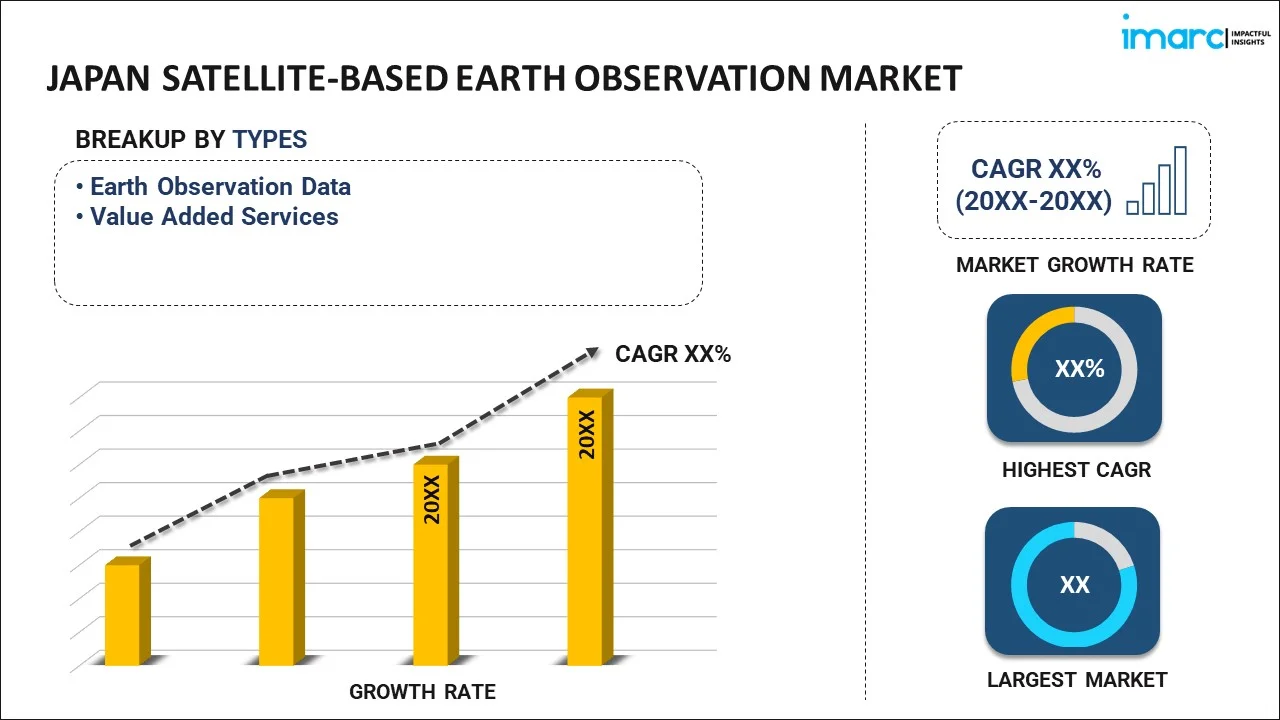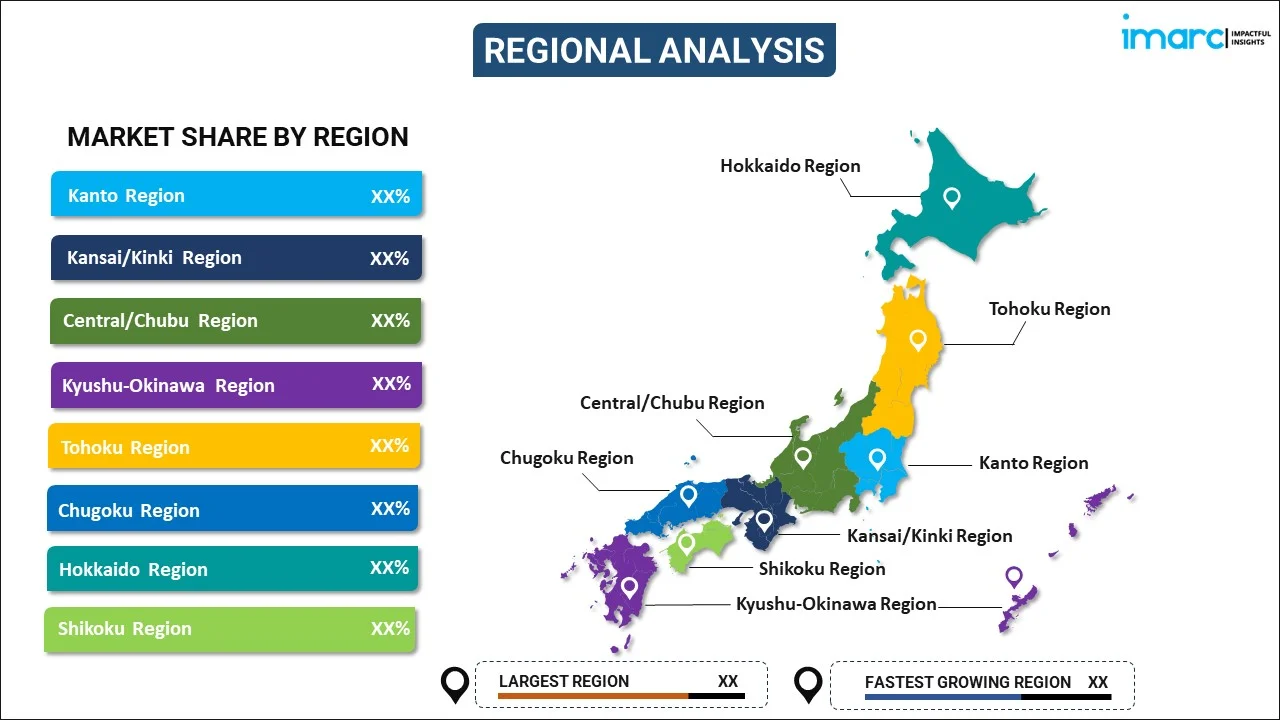
Japan Satellite-Based Earth Observation Market Report by Type (Earth Observation Data, Value Added Services), Satellite Orbit (Low Earth Orbit, Medium Earth Orbit, Geostationary Orbit), End-Use (Urban Development and Cultural Heritage, Agriculture, Climate Services, Energy and Raw Materials, Infrastructure, and Others), and Region 2025-2033
Market Overview:
Japan satellite-based Earth observation market size reached USD 232.1 Million in 2024. Looking forward, IMARC Group expects the market to reach USD 624.4 Million by 2033, exhibiting a growth rate (CAGR) of 11.6% during 2025-2033. The increasing usage of satellite-based Earth observation for intelligence, surveillance, and reconnaissance (ISR) purposes, since they help in monitoring borders, tracking military activities, and supporting national security efforts is primarily driving the market.
|
Report Attribute
|
Key Statistics
|
|---|---|
|
Base Year
|
2024
|
|
Forecast Years
|
2025-2033
|
|
Historical Years
|
2019-2024
|
|
Market Size in 2024
|
USD 232.1 Million |
|
Market Forecast in 2033
|
USD 624.4 Million |
| Market Growth Rate 2025-2033 | 11.6% |
Satellite-based Earth observation is the practice of collecting crucial data about Earth's physical, chemical, and biological systems through remote sensing technologies and survey methods conducted from orbiting satellites. This data plays a pivotal role in forecasting climate patterns, tracking weather fluctuations, monitoring potential disasters and natural catastrophes, identifying oil and mineral deposits, and assessing the availability of water resources. Numerous regional organizations are increasingly depending on satellite-based Earth observation systems to acquire precise and invaluable information for the purpose of data analytics. These systems offer a unique vantage point, enabling the acquisition of comprehensive, real-time data on various Earth-related phenomena. Whether it's monitoring crop health for agricultural planning, tracking deforestation for environmental conservation, or assessing urban sprawl for sustainable development, satellite-based Earth observation provides a wealth of insights that can inform decision-making across diverse sectors. This technology has revolutionized the ability to understand and manage the planet, making it an indispensable tool for addressing regional challenges and fostering sustainable practices.
Japan Satellite-Based Earth Observation Market Trends:
Governments in Japan are promoting the adoption of smart and precise farming techniques due to concerns like decreasing arable land and escalating food security issues. This drive underscores the growing significance of satellite-based Earth observation systems in guiding agricultural practices with valuable information. Furthermore, the deterioration of forested areas, critical for safeguarding people and infrastructure against natural disasters like avalanches, landslides, and rockfalls, has intensified the demand for satellite-based Earth observation in managing protected forests sustainably. In addition to this, satellite-based Earth observation is gaining momentum in sustainable urban planning and rural development, offering high-resolution satellite imagery to monitor urban transformation processes effectively. Moreover, the extensive utilization of high-precision datasets in defense and intelligence sectors for activities such as land surveillance, airfield monitoring, safeguarding critical infrastructure, and crime mapping is contributing significantly to market growth. In addition to this, the emerging trend of automated self-driving vehicles is poised to stimulate the adoption of satellite-based Earth observation systems for navigation and various applications within cars. These multifaceted factors collectively fuel the expansion of the satellite-based Earth observation market in Japan.
Japan Satellite Based Earth Observation Market Segmentation:
IMARC Group provides an analysis of the key trends in each segment of the market, along with forecasts at the country level for 2025-2033. Our report has categorized the market based on type, satellite orbit, and end-use.
Type Insights:

- Earth Observation Data
- Value Added Services
The report has provided a detailed breakup and analysis of the market based on the type. This includes earth observation data and value added services.
Satellite Orbit Insights:
- Low Earth Orbit
- Medium Earth Orbit
- Geostationary Orbit
A detailed breakup and analysis of the market based on the satellite orbit have also been provided in the report. This includes low earth orbit, medium earth orbit, and geostationary orbit.
End-Use Insights:
- Urban Development and Cultural Heritage
- Agriculture
- Climate Services
- Energy and Raw Materials
- Infrastructure
- Others
The report has provided a detailed breakup and analysis of the market based on the end-use. This includes urban development and cultural heritage, agriculture, climate services, energy and raw materials, infrastructure, and others.
Regional Insights:

- Kanto Region
- Kansai/Kinki Region
- Central/ Chubu Region
- Kyushu-Okinawa Region
- Tohoku Region
- Chugoku Region
- Hokkaido Region
- Shikoku Region
The report has also provided a comprehensive analysis of all the major regional markets, which include Kanto Region, Kansai/Kinki Region, Central/ Chubu Region, Kyushu-Okinawa Region, Tohoku Region, Chugoku Region, Hokkaido Region, and Shikoku Region.
Competitive Landscape:
The market research report has also provided a comprehensive analysis of the competitive landscape in the market. Competitive analysis such as market structure, key player positioning, top winning strategies, competitive dashboard, and company evaluation quadrant has been covered in the report. Also, detailed profiles of all major companies have been provided.
Japan Satellite Based Earth Observation Market Report Coverage:
| Report Features | Details |
|---|---|
| Base Year of the Analysis | 2024 |
| Historical Period | 2019-2024 |
| Forecast Period | 2025-2033 |
| Units | Million USD |
| Scope of the Report | Exploration of Historical and Forecast Trends, Industry Catalysts and Challenges, Segment-Wise Historical and Predictive Market Assessment:
|
| Types Covered | Earth Observation Data, Value Added Services |
| Satellite Orbits Covered | Low Earth Orbit, Medium Earth Orbit, Geostationary Orbit |
| End-Uses Covered | Urban Development and Cultural Heritage, Agriculture, Climate Services, Energy and Raw Materials, Infrastructure, Others |
| Regions Covered | Kanto Region, Kansai/Kinki Region, Central/ Chubu Region, Kyushu-Okinawa Region, Tohoku Region, Chugoku Region, Hokkaido Region, Shikoku Region |
| Customization Scope | 10% Free Customization |
| Post-Sale Analyst Support | 10-12 Weeks |
| Delivery Format | PDF and Excel through Email (We can also provide the editable version of the report in PPT/Word format on special request) |
Key Questions Answered in This Report:
- How has the Japan satellite based earth observation market performed so far and how will it perform in the coming years?
- What has been the impact of COVID-19 on the Japan satellite based earth observation market?
- What is the breakup of the Japan satellite based earth observation market on the basis of type?
- What is the breakup of the Japan satellite based earth observation market on the basis of satellite orbit?
- What is the breakup of the Japan satellite based earth observation market on the basis of end-use?
- What are the various stages in the value chain of the Japan satellite based earth observation market?
- What are the key driving factors and challenges in the Japan satellite based earth observation?
- What is the structure of the Japan satellite based earth observation market and who are the key players?
- What is the degree of competition in the Japan satellite based earth observation market?
Key Benefits for Stakeholders:
- IMARC’s industry report offers a comprehensive quantitative analysis of various market segments, historical and current market trends, market forecasts, and dynamics of the Japan satellite based earth observation market from 2019-2033.
- The research report provides the latest information on the market drivers, challenges, and opportunities in the Japan satellite based earth observation market.
- Porter's five forces analysis assist stakeholders in assessing the impact of new entrants, competitive rivalry, supplier power, buyer power, and the threat of substitution. It helps stakeholders to analyze the level of competition within the Japan satellite based earth observation industry and its attractiveness.
- Competitive landscape allows stakeholders to understand their competitive environment and provides an insight into the current positions of key players in the market.
Need more help?
- Speak to our experienced analysts for insights on the current market scenarios.
- Include additional segments and countries to customize the report as per your requirement.
- Gain an unparalleled competitive advantage in your domain by understanding how to utilize the report and positively impacting your operations and revenue.
- For further assistance, please connect with our analysts.
 Inquire Before Buying
Inquire Before Buying
 Speak to an Analyst
Speak to an Analyst
 Request Brochure
Request Brochure
 Request Customization
Request Customization




.webp)




.webp)












